Understanding real estate market trends is crucial before investing, as they shape property values, rental demand, and overall returns. Here are the key areas to focus on:
1. Market Cycles
Real Estate Cycles: Real estate typically moves through four stages—recovery, expansion, hyper-supply, and recession. Knowing where a market is in this cycle helps guide your timing for buying or selling.
Interest Rates: Lower interest rates can stimulate demand and increase property values, while rising rates may dampen demand and affect affordability.
Supply and Demand: High demand with limited supply drives prices up, while oversupply can lead to decreased values. Look at new construction rates and vacancy rates in the area.
2. Local Economic Indicators
Job Growth: Areas with high job growth attract more residents, increasing demand for housing and rentals.
Population Growth: Population influx or outflow can impact housing needs. Young professionals and retiring baby boomers often drive demand in urban and suburban areas.
Median Income: Median income levels are indicators of affordability and purchasing power, which can impact property demand and rental prices.
3. Property Type Trends
Residential vs. Commercial: Residential markets can be more stable, but commercial properties can offer higher returns. Trends in remote work, for instance, have altered demand for office space, affecting commercial real estate.
Single-Family vs. Multi-Family: Single-family homes are often attractive for capital appreciation, while multi-family properties offer steady rental income. Be aware of tenant demand, vacancy rates, and rent trends.
Alternative Assets: Mixed-use developments, warehouses, and data centers are emerging as attractive assets, especially in urban or industrial areas.
4. Housing Affordability and Demographics
Affordable Housing Demand: Rising home prices can drive demand for affordable rentals, creating opportunities in multi-family or workforce housing.
Generational Shifts: Millennials are now significant homebuyers, while Baby Boomers may look to downsize. These trends can shift demand in specific areas or property types.
5. Government and Regulatory Environment
Zoning Laws: Zoning changes or restrictions impact what types of properties can be developed. Areas with relaxed zoning laws may see more new construction and potentially lower property values.
Incentives and Subsidies: Tax breaks, subsidies, or incentives for investing in certain neighborhoods (e.g., Opportunity Zones) can make certain areas more attractive for investment.
Rent Control Policies: Rent control can cap potential rental income. Stay informed on policies that may limit rental rates or add extra regulations for landlords.
6. Technology and Sustainability
Smart Homes and Tech: Properties with smart home features or tech-integrated spaces are becoming popular and can attract a premium.
Sustainable and Green Buildings: Energy-efficient properties are in demand, and some cities are increasingly mandating green building standards. Such properties may have lower utility costs and appeal to eco-conscious renters or buyers.
7. Market Data and Analytics
Price and Rent Trends: Track average sale prices, rental yields, cap rates, and vacancy rates in target markets.
Absorption Rate: This rate, which measures the rate at which available properties are sold, shows how fast homes are selling. A high rate indicates high demand, which could drive prices up.
8. Real Estate Investment Strategies
Buy-and-Hold: This long-term strategy aims for appreciation over time, often focusing on rental income and property value growth.
Flipping: This strategy involves buying properties, improving them, and selling quickly for a profit. It’s sensitive to market volatility and requires good timing.
REITs and Crowdfunding: For a less hands-on approach, consider Real Estate Investment Trusts (REITs) or crowdfunding platforms that allow you to invest in properties with lower capital.
Final Tips:
Research Local Markets: National trends matter, but real estate is highly localized. A market may be booming in one city while stagnant in another.
Professional Guidance: Work with a knowledgeable real estate agent or investment advisor for local expertise and insight.
Stay Updated: The real estate landscape can change quickly. Regularly review market data, economic reports, and policy changes.
Understanding these factors will help you make informed decisions and maximize returns in the real estate market.




















